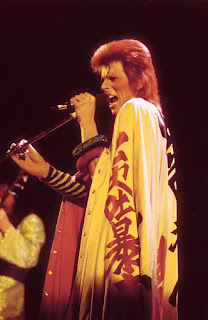Tony Bravo is a San Francisco Chronicle staff writer. E-mail:
tbravo@sfchronicle.com
When the news of David Bowie’s death was confirmed Sunday night, it wasn’t just one picture that flashed through my mind: It was a series of images of the artist in the many personae that spanned his years in the public eye.
There he was, lounging in a dress, transgressing against gender norms on the cover of “The Man Who Sold the World,” then as flame-haired alien Ziggy Stardust in his glittery spaceman jumpsuits, only to morph into Aladdin Sane with the signature lightning bolt painted across his face.
Even the more traditional sartorial looks of his Thin White Duke character during his Berlin years and for his role in the film “The Man Who Fell to Earth” were startling: The mix of classic suiting with his delicate androgyny continues to inspire designers from Jean Paul Gaultier to Hedi Slimane.
These are only a few of the ways in which Bowie endures as an icon of style and fashion. There are so many other fashion stops Bowie took in between, including side trips to boy-next-door sportswear circa “Young Americans” in the mid-1970s, the New Wave-influenced designs of the 1980s, and even an elegant Pierrot in his “Ashes to Ashes” music video.
When it came to fashion, there was nothing he wouldn’t borrow to create his melange, from high-concept contemporary art to low street style. That rich rock ’n’ roll voice remained immediately recognizable over the decades of his career, but the look was ever-changing, a reflection of what he expressed in his experiments with sounds on his albums and for characters on stage and screen.
“It was a persona, a series of personae, but done in a very authentic way,” said fashion designer Keanan Duffty, who collaborated with Bowie in 2007 on a collection for Target. “He was almost a mirror for the culture.”
His fashion evolution set the stage for those who followed him in pop culture, from Grace Jones and Madonna to Lady Gaga, but his dedication to pushing boundaries in his stage and personal style also influenced everyday fans. Since the 1970s, Bowie’s music has been the soundtrack for the creatively minded outsider, and his different looks allowed those same people to embrace their own “other” aesthetics.
“My whole relationship with Bowie started when I was 13, and I bought a copy of ‘Aladdin Sane’ when I didn’t have a record player,” Academy Award-winning actress Tilda Swinton (whose resemblance to Bowie has been frequently commented on) told Marlow Stern for the Daily Beast in 2014.
“He just looked like me, and looked like someone (who came) from the same planet as I did, and that was a great comfort to me at the time when I was 13 and 14 looking like that, that someone not only looked like that, but felt proud enough to stick themselves on the front of an album with a zigzag across their face and a dewy collarbone.”
My childhood in San Francisco in the 1990s was colored by my discoveries of the various Bowie eras. Like many in my generation, my first memories of Bowie are from his role as Jareth the Goblin King in Jim Henson’s 1986 fantasy film “Labyrinth.” How I wished that he’d spirit me away to the masquerade ball in his castle beyond the title maze, where he’d dress me in skintight spandex and swooping cloaks and line my eyes pearly white like his character.
There were tinglings of other yearnings in those early viewings too, and as I later delved deeper into his music, I understood that the bisexual Bowie wasn’t just family by nature of his fashion experimentation, he was quite simply “family” (as the LGBT community calls members and allies). Duffty points out that Bowie’s understanding of sub- and counterculture styles fueled his ability to freely borrow and adapt elements for his own looks. Bowie’s many personae became subcultures unto themselves that fans re-created and borrowed from for Bowie Balls, held annually in New York and Los Angeles.
The first time I applied glitter across my eyelids as a teen, it was while listening to Bowie’s “Velvet Goldmine.” When I dyed my hair a shocking orange and flipped the collar up on my leather jacket, I was emulating the cover of his album “Low.” When “Heathen” debuted in 2002, I began to notice the subtle distortions of his suiting that he wore in the liner-note photos that introduced me to the same types of fashion created by the Antwerp Six. Bowie was a gateway for me into high fashion by proving it could be a vehicle for not only great chic, but nonconformity.
There are some looks that will possibly always belong to Bowie. The silver striped jumpsuit with ballooned legs will always be Ziggy’s, no matter how many designers reinterpret it, and his spiked longer-in-the-back-shorter-on-top-hairdo remains the only acceptable version of the mullet.
The 2013 Victoria and Albert Museum exhibition “David Bowie Is” displayed many of these looks, and his influence can especially be seen today in the fashion industry with the move toward non binary design (clothes that don’t conform to traditional gender stereotypes) at labels like Hood by Air and Louis Vuitton, and returns to glam
dandyism at Gucci and Saint Laurent.
For many, Bowie’s most significant contribution to fashion will remain the permission he gave through his own style expression to push the boundaries toward greater avant-garde authenticity.
“I wouldn’t have become a designer if I hadn’t had David Bowie’s music and performances as a guiding light as a kid,” Duffty says. “I think that will be true of a lot of people. You can try and emulate him but he always moved on. No one will ever be Bowie.”


No comments:
Post a Comment